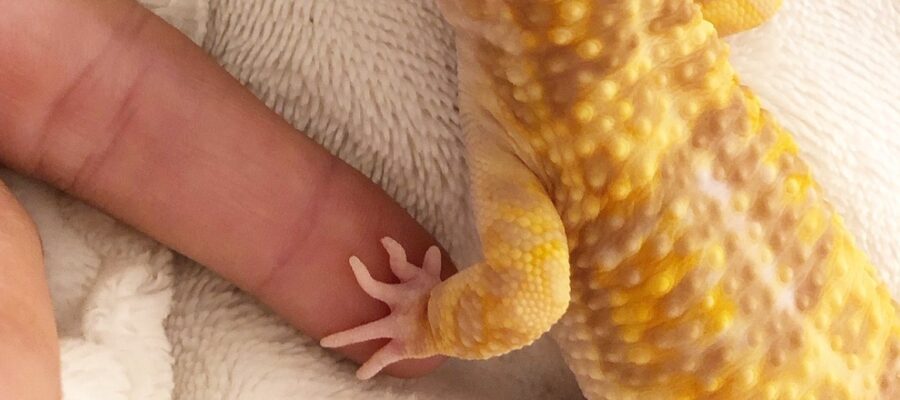So, you’ve decided that buying a leopard gecko is the right thing for you – congratulations as they are a fantastic pet. Not only are they relatively easy to care for, but they are friendly, funny and fascinating!
Hopefully you have already done your research on handling and taming, housing and setup and feeding, and have read my post on Things to consider before getting a leopard gecko. Your next step is to find where you can buy a leopard gecko, and understand what to look out for when choosing a healthy* leopard gecko.
*If you are looking to “rescue” an unhealthy, neglected leopard gecko, this isn’t the right post for you. This post is intended for new owners. I am not discouraging people from taking in unhealthy geckos to nurse back to health, however if you are a beginner to owning reptiles; taking on a gecko which is unhealthy may be too much of a challenge, even if it is heartbreaking to see one in poor conditions.
Before you buy:
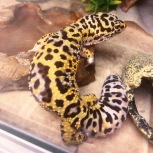
Make sure you already have their set up complete before you buy the gecko. This can take a while, and ideally you want to put your gecko straight into their perfect enclosure.
See the following posts on housing and setup to see what to buy for their setup:
- A beginner’s guide to leopard gecko housing and setup
- How to set up floor heating for leopard geckos
- Does sand/ loose substrate cause impaction in leopard geckos?
Where to buy:
- Pet stores: chain pet stores will sometimes sell reptiles, but it’s probably better to go to a specialist reptile shop
- Local breeders
- Online: Search for people in your area selling leopard geckos on sites such as Gumtree.com – you’ll find a mixture of people breeding leopard geckos, or people selling their older unwanted leopard geckos
- Unwanted geckos: Websites such as PreLoved have categories where people can sell their unwanted pets. Unfortunately there are lots of people selling leopard geckos, s they live for a long time and are quite a long term commitment
How to choose a healthy leopard gecko:
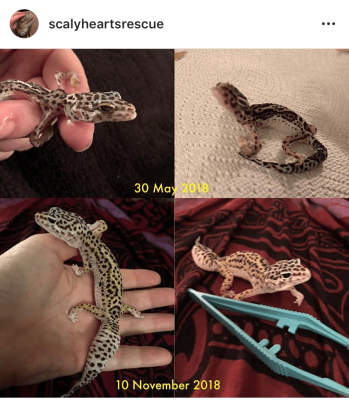
- Healthy leopard geckos should have a plump belly and a thick, fleshy tail (which is where they store fat). An unhealthy or malnourished leopard gecko will have a thin looking tail and body.
- An overweight gecko will have a belly so large that it touches the floor when the gecko walks. If the gecko is overweight, try to find out what it has been fed on. A leopard gecko which is addicted to waxworms will be unlikely to want to eat any other insects.
- Leopard geckos can develop an illness called metabolic bone disease if they are malnourished or on the wrong diet. Signs of this are limbs which are bent, out of shape, and cannot properly support the gecko.
- Check that their eyes are clear, and that their skin is smooth with no abrasions or cuts.
- Try to get proof that the leopard gecko is eating, pooping and shedding as expected. A baby (up to about 8 months old) should be shedding around every 2 weeks, and eating/pooping daily. An adult should be shedding around once per month, and eating 2-3 times a week, with regular pooping a couple of times per week.
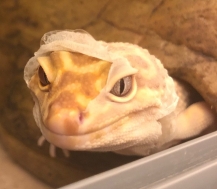
A healthy leopard gecko mid-shed. Stuck shed is easy to take off, but make sure there isn’t a huge build up around the face, toes or tail, as this may be a challenge for a novice owner to remove
- Check that they are shedding properly by looking closely at their fingers, around their eyes/nose, and around their tail to make sure there is no shed stuck. Shed will get stuck from time to time, but a healthy gecko shouldn’t have shed, or a thick build up of shed, in any parts of its body. If it does have stuck shed, and you still want to buy this gecko, you may have a challenge to remove the shed. Please see my post on shedding for more information.
- Their poop should be mainly firm, brown and relatively untextured, with a smaller white bit called urate (a salt derived from uric acid). Leopard geckos do not urinate, but their poop will be quite damp when it is recently excreted.
- See which substrate they are being kept on… if they are kept on loose substrate, there is a risk that they could be (or become) impacted.
See: Does sand/ loose substrate cause impaction in leopard geckos? - Finally, your leopard gecko should be over 6 weeks old before being sold to you. Try to find out when they hatched before purchasing!
Summary:
From what I’ve seen, big chain pet stores tend to keep their geckos in worse conditions than specialist breeders do, so do your research before buying.
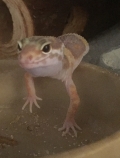 Also, make sure you understand as much as you can before even entering a pet store. Unfortunately, they will try to sell you things you don’t need because they want you to keep purchasing and repurchasing from them, even though it may be harmful to your leopard gecko. Two perfect examples of this are overhead heating/ lights (see: A beginner’s guide to leopard gecko housing and setup) and sand substrate (see: Does sand/ loose substrate cause impaction in leopard geckos?) which is actually REALLY dangerous for leopard geckos.
Also, make sure you understand as much as you can before even entering a pet store. Unfortunately, they will try to sell you things you don’t need because they want you to keep purchasing and repurchasing from them, even though it may be harmful to your leopard gecko. Two perfect examples of this are overhead heating/ lights (see: A beginner’s guide to leopard gecko housing and setup) and sand substrate (see: Does sand/ loose substrate cause impaction in leopard geckos?) which is actually REALLY dangerous for leopard geckos.
I really hope this helps, please take a browse of all my other posts, I have tried to cover as much as I can 🙂
Related Posts:
- Which is the best substrate for leopard geckos?
- A beginner’s guide to leopard gecko housing and setup
- A beginner’s guide to feeding leopard geckos
- How to tame a leopard gecko
- How to set up floor heating for leopard geckos
- Things to consider before getting a leopard gecko
We are now selling lino substrate: click here to purchase some
Get Your Free Leopard Gecko Care Checklist!
Are you ready to give your leopard gecko the best care possible? Download our FREE PDF e-book featuring a comprehensive care checklist!
This handy guide covers everything from habitat setup to feeding and health tips, ensuring your gecko thrives.
👉 Download your checklist now!


